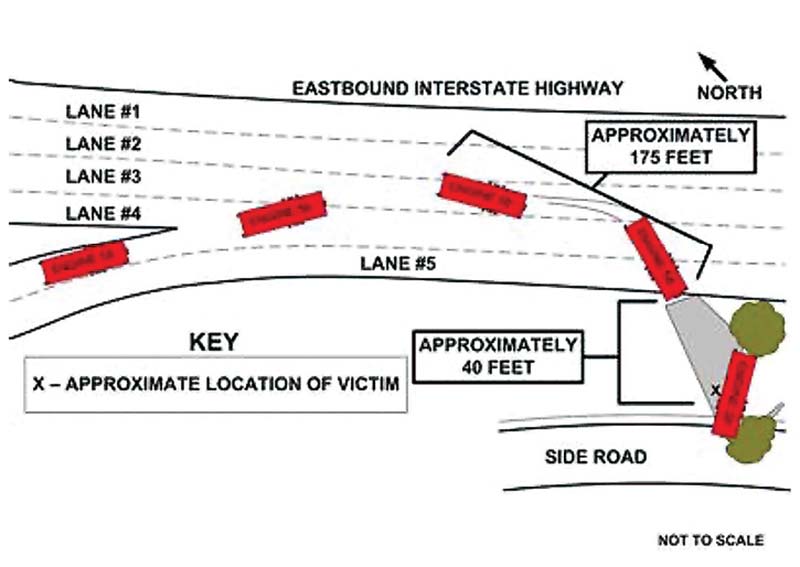Drive to Survive: Case Studies Chris Daly
On August 5, 2005, a fire apparatus crashed in California, resulting in the death of a 23-year-old firefighter. The crew was responding nonemergency in heavy rain to a report of a flooded basement.
The apparatus involved was a reserve engine and the driver was traveling at approximately 45 miles per hour when the driver lost control and the apparatus left the roadway. The apparatus traveled down an embankment and struck two trees. The victim firefighter was ejected from the open cab and found lying under the passenger side running board of the apparatus.
Driver Considerations
An investigation revealed that the auxiliary braking system had been in the high-power position at the time of the crash. In addition, the vehicle involved was a reserve engine and the fire apparatus operator may not have been familiar with its quirks and nuances. Fire apparatus operators must remember to turn off the auxiliary braking system in wet or slick weather, as the sudden engagement of this braking system could lead to a loss of control. Fire apparatus operators must also use extreme caution when operating an unfamiliar vehicle. Reserve apparatus tend to be older, may have unusual driving characteristics because of their age, and may not have the updated safety and stability control systems that a newer apparatus is equipped with. Finally, fire apparatus operators must ensure that all occupants of the apparatus are in seat belts prior to moving the rig. In this case, two firefighters were not wearing their seat belts and were ejected from the apparatus.

Figure 1: Crash Diagram. (Source: Courtesy of NIOSH Report.)
Driver Training Considerations
Driver training programs must address the fact that fire apparatus operators should turn off the auxiliary braking device during slick or inclement weather. Furthermore, driver training programs should include time behind the wheel of an apparatus with the auxiliary braking system turned off. This is because many driver trainees complete all of their training time behind the wheel on dry roads with no adverse conditions. After becoming qualified to drive the apparatus to an emergency call, the driver is suddenly faced with driving the apparatus in inclement weather. The driver turns off the auxiliary brake like he is supposed to but is not familiar with the significant change in the apparatus’ handling characteristics now that the auxiliary brake has been turned off. Allowing new fire apparatus operators an opportunity to drive under controlled and supervised conditions with the auxiliary brake turned off should be a crucial part of any driver training program. During this training module, new drivers should also become familiar with the issues related to brake fade. Because the auxiliary brake is turned off and no longer helping to absorb the vehicle’s kinetic energy, the brakes are doing all of the work and are more prone to overheat and fade.
Relevant National Fire Protection Association (NFPA) Standards
NFPA 1500 – 6.2.12: “The fire department shall include information on the potential hazards of retarders, such as engine, transmission, and driveline retarders, in the driver training program and shall develop written procedures pertaining to the use of such retarders.”
>NFPA 1451 – 5.3.10: “Where applicable, the FESO driver training program shall include information on the potential hazards of retarders, such as engine, transmission, driveline retarders, antilock braking system (ABS) brakes, vehicle stability system, and traction control systems, and shall develop written standard operating procedures pertaining to the use of such devices.”
Teaching Resources
“Fire Apparatus Rollovers, Part 10: Old Guy Rules”—Fire Apparatus & Emergency Equipment, January 2020, which explains the issues of using auxiliary braking devices on a slick road in greater detail.1
“Drive to Survive: The Art of Wheeling the Rig,” Chapter 5–Page 58 and Page 65–EVOC textbook available from Fire Engineering Books and Videos2, which also explains the issues related to using auxiliary braking devices on a slick road.
Endnotes
1. https://www.fireapparatusmagazine.com/fire-apparatus/fire-apparatus-rollovers-part-10-old-guy-rules/#gref.
2. https://fireengineeringbooks.com/drive-to-survive/.
Chris Daly is a 24-year police veteran and an accredited crash reconstructionist (ACTAR #1863), having served as a lead investigator for the Chester County Serious Crash Assistance Team. In addition to his police duties, he has served in the fire service for more than 32 years including time as both a career and volunteer firefighter, holding numerous positions including assistant chief. He has a master’s degree in environmental health engineering from Johns Hopkins University and is a contributing author to numerous fire service professional publications including Fire Apparatus & Emergency Equipment and Fire Engineering. He has also developed an emergency vehicle driver training program entitled “Drive to Survive,” which has been presented to more than 24,000 firefighters and police officers at more than 565 emergency service agencies across the United States. He is the author of the EVOC textbook Drive to Survive–The Art of Wheeling the Rig (Fire Engineering). Additional resources concerning emergency vehicle crash reconstruction and seminar scheduling can be found at his Web site www.drivetosurvive.org.

